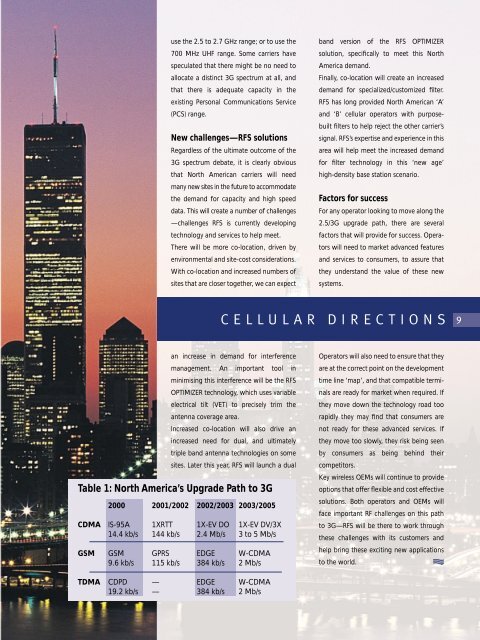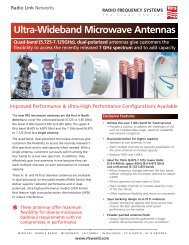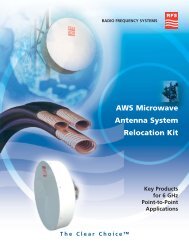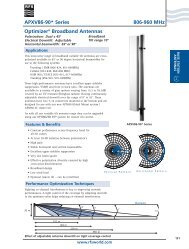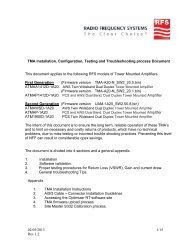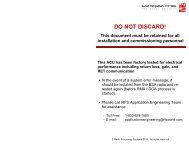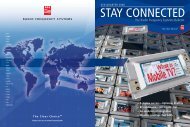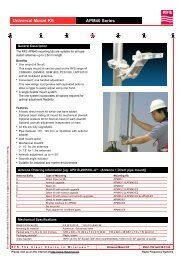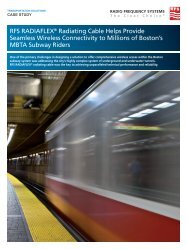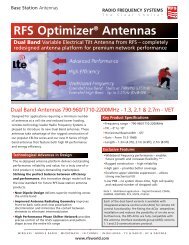download - Radio Frequency Systems
download - Radio Frequency Systems
download - Radio Frequency Systems
You also want an ePaper? Increase the reach of your titles
YUMPU automatically turns print PDFs into web optimized ePapers that Google loves.
use the 2.5 to 2.7 GHz range; or to use the<br />
700 MHz UHF range. Some carriers have<br />
speculated that there might be no need to<br />
allocate a distinct 3G spectrum at all, and<br />
that there is adequate capacity in the<br />
existing Personal Communications Service<br />
(PCS) range.<br />
New challenges—RFS solutions<br />
Regardless of the ultimate outcome of the<br />
3G spectrum debate, it is clearly obvious<br />
that North American carriers will need<br />
many new sites in the future to accommodate<br />
the demand for capacity and high speed<br />
data. This will create a number of challenges<br />
—challenges RFS is currently developing<br />
technology and services to help meet.<br />
There will be more co-location, driven by<br />
environmental and site-cost considerations.<br />
With co-location and increased numbers of<br />
sites that are closer together, we can expect<br />
band version of the RFS OPTIMIZER<br />
solution, specifically to meet this North<br />
America demand.<br />
Finally, co-location will create an increased<br />
demand for specialized/customized filter.<br />
RFS has long provided North American ‘A’<br />
and ‘B’ cellular operators with purposebuilt<br />
filters to help reject the other carrier’s<br />
signal. RFS’s expertise and experience in this<br />
area will help meet the increased demand<br />
for filter technology in this ‘new age’<br />
high-density base station scenario.<br />
Factors for success<br />
For any operator looking to move along the<br />
2.5/3G upgrade path, there are several<br />
factors that will provide for success. Operators<br />
will need to market advanced features<br />
and services to consumers, to assure that<br />
they understand the value of these new<br />
systems.<br />
CELLULAR DIRECTIONS<br />
9<br />
an increase in demand for interference<br />
management. An important tool in<br />
minimising this interference will be the RFS<br />
OPTIMIZER technology, which uses variable<br />
electrical tilt (VET) to precisely trim the<br />
antenna coverage area.<br />
Increased co-location will also drive an<br />
increased need for dual, and ultimately<br />
triple band antenna technologies on some<br />
sites. Later this year, RFS will launch a dual<br />
Table 1: North America’s Upgrade Path to 3G<br />
2000 2001/2002 2002/2003 2003/2005<br />
CDMA IS-95A 1XRTT 1X-EV DO 1X-EV DV/3X<br />
14.4 kb/s 144 kb/s 2.4 Mb/s 3 to 5 Mb/s<br />
GSM GSM GPRS EDGE W-CDMA<br />
9.6 kb/s 115 kb/s 384 kb/s 2 Mb/s<br />
Operators will also need to ensure that they<br />
are at the correct point on the development<br />
time line ‘map’, and that compatible terminals<br />
are ready for market when required. If<br />
they move down the technology road too<br />
rapidly they may find that consumers are<br />
not ready for these advanced services. If<br />
they move too slowly, they risk being seen<br />
by consumers as being behind their<br />
competitors.<br />
Key wireless OEMs will continue to provide<br />
options that offer flexible and cost effective<br />
solutions. Both operators and OEMs will<br />
face important RF challenges on this path<br />
to 3G—RFS will be there to work through<br />
these challenges with its customers and<br />
help bring these exciting new applications<br />
to the world.<br />
TDMA CDPD — EDGE W-CDMA<br />
19.2 kb/s — 384 kb/s 2 Mb/s


